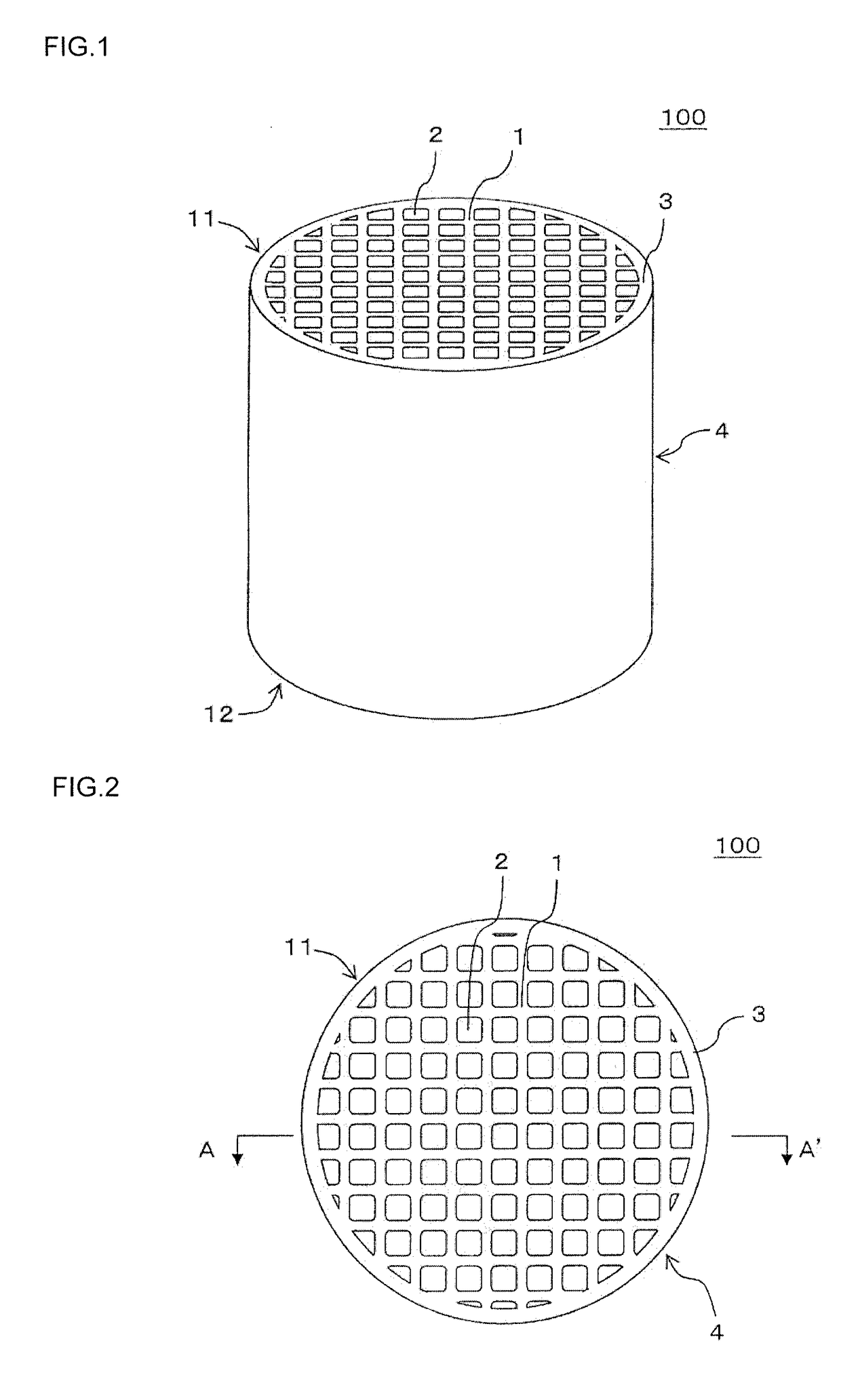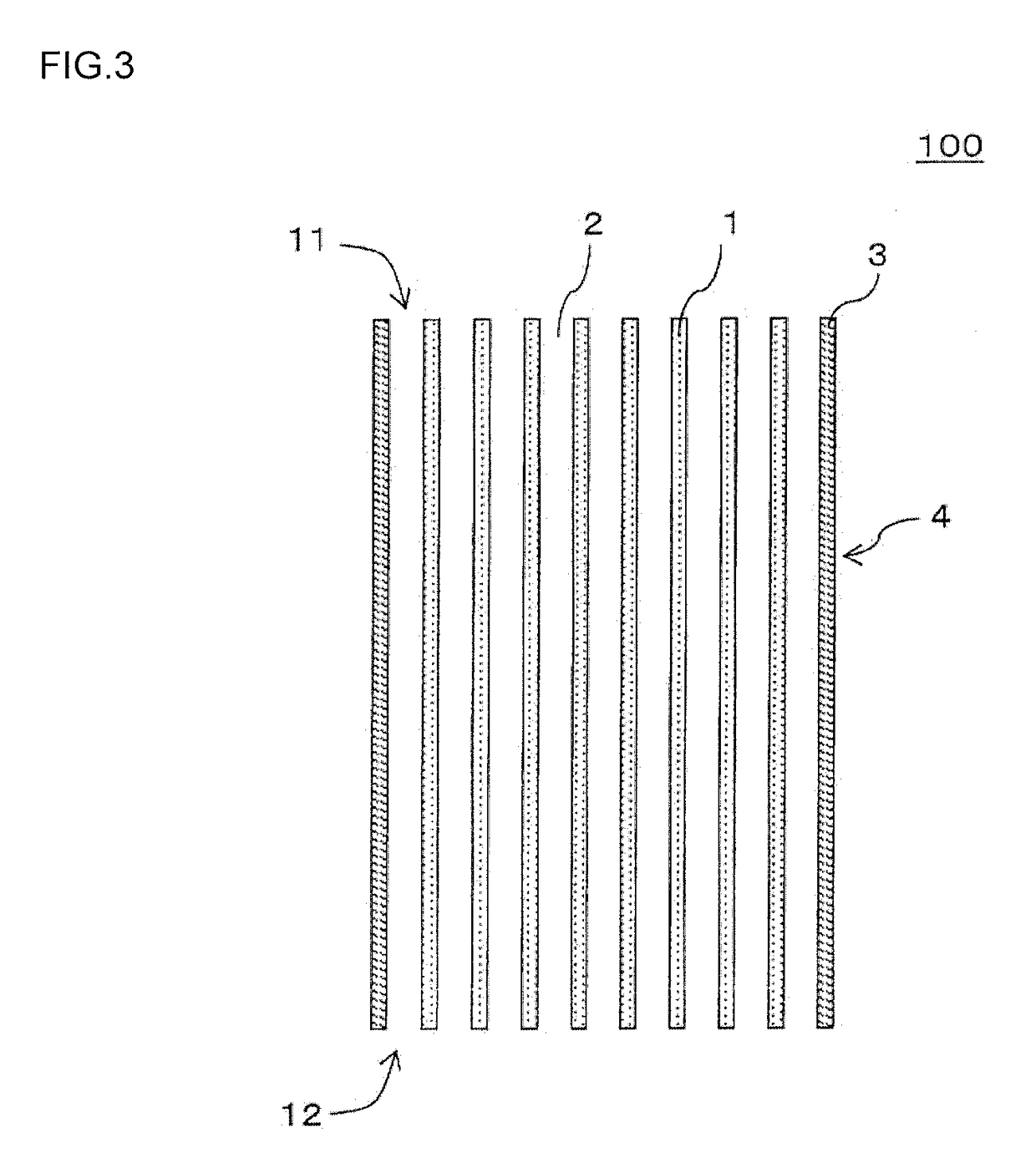Manufacturing method of honeycomb structure
- Summary
- Abstract
- Description
- Claims
- Application Information
AI Technical Summary
Benefits of technology
Problems solved by technology
Method used
Image
Examples
example 1
[0062]In Example 1, first, by the following method, a forming raw material was prepared. First, as a cordierite forming material, talc, kaolin, alumina, aluminum hydroxide and silica were prepared. An organic binder and an inorganic binder were added to this cordierite forming material. As the organic binder, methylcellulose was used. As the inorganic binder, montmorillonite was used in which at least parts of interlayer metal cations were ion-exchanged with amine ions. Montmorillonite is one type of smectite. Hereinafter, montmorillonite in which at least parts of the interlayer metal cations are ion-exchanged with the amine ions will be referred to as “an amine-substituted montmorillonite” sometimes. In the amine-substituted montmorillonite used in Example 1, a total amount of sodium to be contained in the amine-substituted montmorillonite was 1.58 mass % in terms of oxides to 100 mass % of the amine-substituted montmorillonite. Table 1 shows a chemical composition (mass %) of sme...
examples 2 to 6 and 8 to 11
[0070]In each of Examples 2 to 6 and 8 to 11, an amine-substituted montmorillonite of such a chemical composition as shown in Table 1 was used. Further, a content ratio of the amine-substituted montmorillonite in a forming raw material was changed as shown in Table 1, and amounts of talc, kaolin, alumina, aluminum hydroxide and silica in a cordierite forming material were suitably adjusted so that the composition became close to a cordierite composition. As to a manufacturing method other than this method, the procedure of Example 1 was repeated to manufacture 10 honeycomb structures. As to each obtained honeycomb structure, evaluation of crack defects during firing and measurement of a thermal expansion coefficient were carried out. Table 1 shows the results.
example 7
[0071]In Example 7, first, by the following method, a forming raw material was prepared. As a cordierite forming material, talc, kaolin, alumina, aluminum hydroxide and silica were prepared. An organic binder and an inorganic binder were added to this cordierite forming material. As the organic binder, methylcellulose was used. As the inorganic binder, hectorite was used in which at least parts of interlayer metal cations were ion-exchanged with amine ions. Hectorite is one type of smectite. Hereinafter, hectorite in which at least parts of the interlayer metal cations are ion-exchanged with the amine ions will be referred to as “an amine-substituted hectorite” sometimes. In the amine-substituted hectorite used in Example 7, a total amount of sodium to be contained in the amine-substituted hectorite was 0.76 mass % in terms of oxides to 100 mass % of the amine-substituted hectorite. Table 1 shows a chemical composition (mass %) of smectite used as the inorganic binder.
[0072]A conten...
PUM
| Property | Measurement | Unit |
|---|---|---|
| Percent by mass | aaaaa | aaaaa |
| Percent by mass | aaaaa | aaaaa |
| Percent by mass | aaaaa | aaaaa |
Abstract
Description
Claims
Application Information
 Login to View More
Login to View More - R&D
- Intellectual Property
- Life Sciences
- Materials
- Tech Scout
- Unparalleled Data Quality
- Higher Quality Content
- 60% Fewer Hallucinations
Browse by: Latest US Patents, China's latest patents, Technical Efficacy Thesaurus, Application Domain, Technology Topic, Popular Technical Reports.
© 2025 PatSnap. All rights reserved.Legal|Privacy policy|Modern Slavery Act Transparency Statement|Sitemap|About US| Contact US: help@patsnap.com



